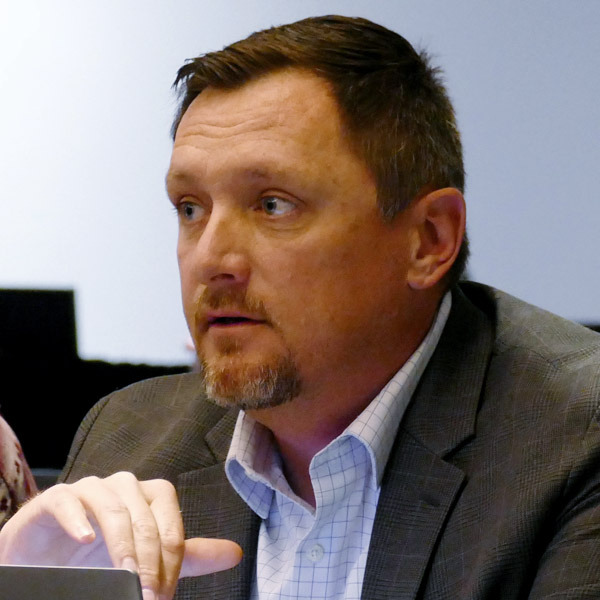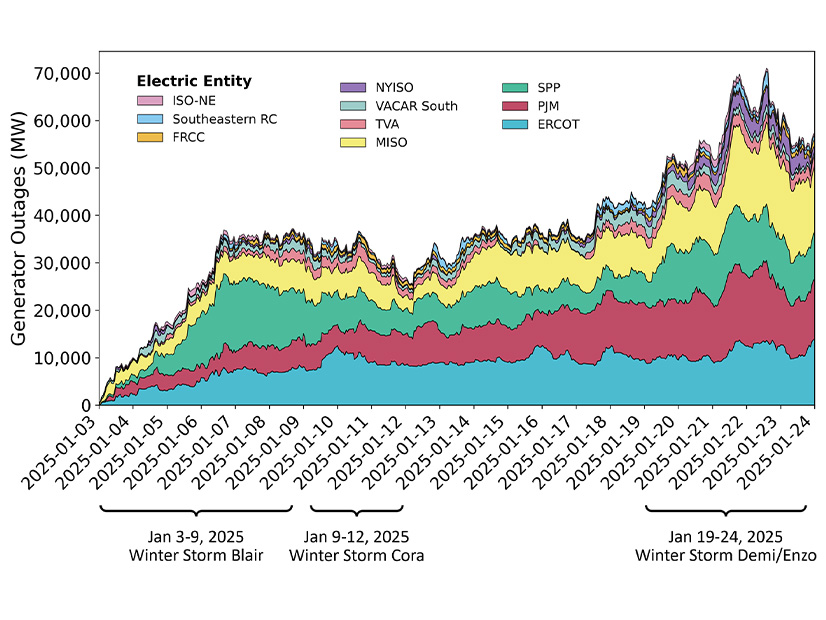HOUSTON — Texas has shown itself as capable as any state of building big things. And ERCOT is the one organized market that saw demand growth over the past two decades as it benefited from population shifts to the Sun Belt and booming industry.
The latest forecasts are so large, however, that meeting whatever fraction comes to fruition is daunting. That issue dominated discussions at the Gulf Coast Power Association’s recent Spring Conference. (See GCPA Hears Different Tales on Texas Load Growth from 2 CEOs.)
The market’s all-time peak is about 85 GW, and forecasts claim that could triple by the end of the decade due largely to new large loads from data centers, cryptocurrency mining, reshoring of industry and hydrogen production.
“I think that’s driven by the opportunities that are created by the Texas market, plus, you know, just the natural resources that Texas has,” said Goff Policy President Eric Goff. “So, it probably won’t be as big as the number ERCOT publishes, in part because they’re required to follow a particular methodology established in state law. But, also, it’s going to be big.”
The industry should take the eye-popping numbers in ERCOT’s forecasts with a grain of salt as it does similar figures on the supply side, said American Clean Power Association Senior Director Charlie Hemmeline. ERCOT’s queue similarly has eye-popping numbers in terms of nameplate capacity.
“There’s a lot of plans,” Hemmeline said. “Many of those plans work out, and many don’t. And so just being smart about what the future holds.”
Texas is trying to get more dispatchable generation onto the grid through the Texas Energy Fund (TEF), which has seen projects drop out recently. (See 2 More Projects Fall out of TEF Loan Program.)
Calpine has one project competing for state money. Its Vice President of Government and Regulatory Affairs Bryan Sams wondered how generous the Legislature will be, with different amounts allocated in the House and Senate this session.
“I think market design really is the answer for what needs to happen to build plants, but it helps at the margins,” Sams said.
The TEF gives the Public Utility Commission a new role, acting like a bank, and it is learning that job on the fly, he added. The program also comes with restrictions that could cause more projects to drop out, such as being required to sell 50% of capacity to the grid. Sams said firms could find a better deal co-locating with a data center and might leave the fund for that option.
“One of the things that I’m watching out of the TEF over the next few years is, do we see more natural gas turbines installed outside of TEF than inside TEF, and if so, what does that say to the health of our market and our market design?” Goff said.
ERCOT is working on new rules to deal with large loads seeking to connect to the grid. Those loads are defined as anything with a demand of 75 MW or above, said Large Load Integration Team Supervisor Julie Snitman. It has some interim rules to catch new sources of demand while more permanent fixes are worked out.
“This era of large loads is forcing us and the entire industry, really, to have to think about planning a whole new way,” Snitman said. “I think it’s really challenging a lot of our existing and preconceived notions about how to plan, particularly when the assumptions you’re making in these planning cases are shifting under you — often quite dramatically and quite quickly.”
The customer behind a request can change while it’s pending in ERCOT’s process, which can change how that load will affect the grid, she added. Some customers have flexible requirements, but others require 24/7 power, and that can change at specific sites while ERCOT examines their impact.
The interim process requires loads looking to interconnect within two years to register with ERCOT. But more customers planning large facilities are getting into the process with longer-term plans than that. Rules for longer lead times begin in May, so some are getting ahead of that.
“Also, I think increasingly there’s less and less space available in the near-term system, and a lot of clients are starting to recognize that, and so they’re pushing out those interconnect requests a little bit further than that two-year mark in the queue,” Snitman said.
Supply chain issues have been well documented on the supply side, but Brad Richter, senior vice president of Hut 8, said his firm, which develops Bitcoin mines and other data centers along with their required energy infrastructure, has seen large loads running into the same issue.
“These 345 breakers, there are two manufacturers of these worldwide,” Richter said. “And the interconnection queue on that side of things is also long, and whether you’re stepping up or stepping down, you need that equipment.”
Other jurisdictions have asked to stop large load development altogether as they’ve been swamped. At some point, ERCOT might need to weed out unrealistic projects to avoid that situation, he added.
Prospects for Another Round of Transmission Expansion
Large loads are a huge issue facing planners. They are harder to deal with than renewables because they come online faster and ERCOT cannot curtail customer demand like it can with power plants’ excess generation, said Zero Emission Grid President Mike Tabrizi. One area they have in common with renewables is the need for transmission.
“I think the main issue is not supply,” Tabrizi said. “The main issue is the transmission. You can have a single line. You can have an unlimited amount of generation on one side of this line. But it doesn’t mean that we can transfer all this out to the line, right? So, I think the main fundamental right now is that transmission is not being developed.”
Transmission expansion is important to former PUC Commissioner Will McAdams, who runs the McAdams Energy Group. Regulators will decide soon on whether to build 765-kV lines to help to serve Permian Basin oil production in West Texas. If they do, it follows that 765-kV lines will be built in the east of the state to support load growth around its major cities and from large customers.
“It’s a no-brainer to me, because that’s the one thing that we can guarantee the immediacy, or have more control over the immediacy, of integration and interconnectivity across the system,” McAdams said.
The Legislature has indicated it wants to keep ERCOT mostly isolated from the rest of North America’s grid. That will require more transmission within Texas to manage the new demand and supply.
“Then we need an extremely integrated system within that island in order to support ourselves,” McAdams said.
While ERCOT is likely to keep its jurisdictional status, one line that could increase its exposure to the Eastern Interconnection is Pattern Energy’s Southern Spirit line. It would connect to MISO South with full construction scheduled to start in 2029. Pattern Vice President of Origination Holly Adams noted that her firm has another HVDC merchant project linking New Mexico and California, while Grid United plans one to connect ERCOT and SPP.
“Our opinion is all the projects on this list should actually get built out,” Adams said. “There’s a lot of need for it. But I do think the ERCOT to MISO South, just in proximity for the Texas triangle, the big load growth — I think it’s really important to get that project built out.”
NERC’s studies on interregional transfer capability have shown that connecting ERCOT to MISO South and SPP would bring reliability benefits, she added. (See NERC Files ITCS to FERC, Meeting Congress’ Deadline.)
NERC studies have shown interregional HVDC lines that are long enough to get into a different weather pattern can improve the reliability of the grid, said Lasher Energy Consulting’s Warren Lasher. But the connection to vastly different market regimes would lead to less generation in Texas over time as the resources on the other side do not face the same competitive pressures that come with ERCOT’s unique market.
“It reminds me of the canals around Chicago, where they’re concerned about invasive fish getting into the Great Lakes,” Lasher said. “You’ve just got to be careful about where you build a connection from one point to another because of the long-term impacts.”
Where Will Needed New Generation Come from?
While transmission is key to serving new load, it cannot accomplish that without enough electrons. That means new generation to meet rising demand.
Vistra Energy develops solar, batteries and natural gas units, but it needs offtake agreements with customers to make renewable projects profitable enough to build. The revenues required for new gas plants increasingly are requiring that too, said Stacey Doré, its chief strategy and sustainability officer.
“We often say in rooms like this, if there are any corporate offtakers for gas plants that want to sign up for a PPA, come and talk to us,” Doré said. “And we typically don’t have a line out the door waiting for that.”
Gas plants need market signals to get built. While Vistra is developing new peaker plants in West Texas that are up for the Texas Energy Fund, it is hedging its bets and could back out of those plans if prices are not enough to justify the final investment, Doré added.
“In ERCOT in particular, where there’s no capacity market, customer choices are driving what gets built, and the customers are demanding renewables, even while our policymakers are saying we need more dispatchable generation,” Doré said. “So I think that’s a disconnect that we still haven’t quite solved in ERCOT yet.”
The existing thermal fleet ran only at 50% capacity factor last year, which means there still is headroom in current generation, she added.
The use of batteries has increased dramatically in ERCOT, with more than 10 GW today, said Jupiter Power CEO Andy Bowman, whose firm develops energy storage projects.
“I think with batteries, they come along so quickly that the market opportunity is still coming together and being articulated in state policy and in ISO policies,” Bowman said. “The opportunity here in ERCOT is very different. The first six projects that we built were built on balance sheet. These were projects that just operated in the market. They operated largely as a natural gas power plant would.”
Jupiter is developing more batteries that are contracted with PPAs, instead of just earning in the wholesale markets, he added. ERCOT will keep building solar and batteries, along with some wind and natural gas, and that will lead to more ramping needs and volatility.
“There’s a pretty good stripe of opportunity that a lot of outside forecasters, which we rely on in our finances and so on, are seeing a really solid revenue opportunity for batteries fitting into ERCOT extending through 2040,” Bowman said.
With a demand super cycle driving investment, there’s no shortage of capital to support new supply. But NRG Energy and other generators have to make enough money to justify investing it, said its Executive Vice President Robert Gaudette.
“Thermal shares a lot of the same question marks as far as, OK, well, ‘who’s wearing a risk on tariffs, or who’s wearing a risk on XYZ and all that,’ but there’s no shortage of capital,” Gaudette said.
A lot of that capital is being deployed into existing assets through merger and acquisition activity, said Vistra’s Doré.
“You can buy those plants for cheaper than you can build new plants,” Doré said. “And as long as that’s the case, capital is going to flow to those assets, because obviously they’re going to have a better return. So, then you have to ask yourself, what does the market need to do to incentivize new generation if we need new generation and how much of it do we need?”
PJM has built three times the amount of natural gas as ERCOT has in the past decade, but it has a capacity market. While that construct is not likely to be added to the Texas grid, Doré argued that something has to change.
“You’ve got to come up with some market mechanism that rewards reliability, because the fact of the matter is we have plenty of energy,” Doré said. “I mean, on your average day in ERCOT, we have a lot of excess energy. We have plenty of energy. What we don’t have quite enough of is the capacity that’s needed to fill in the gaps on the peak days when perhaps renewables, for example, are not performing as expected.”



